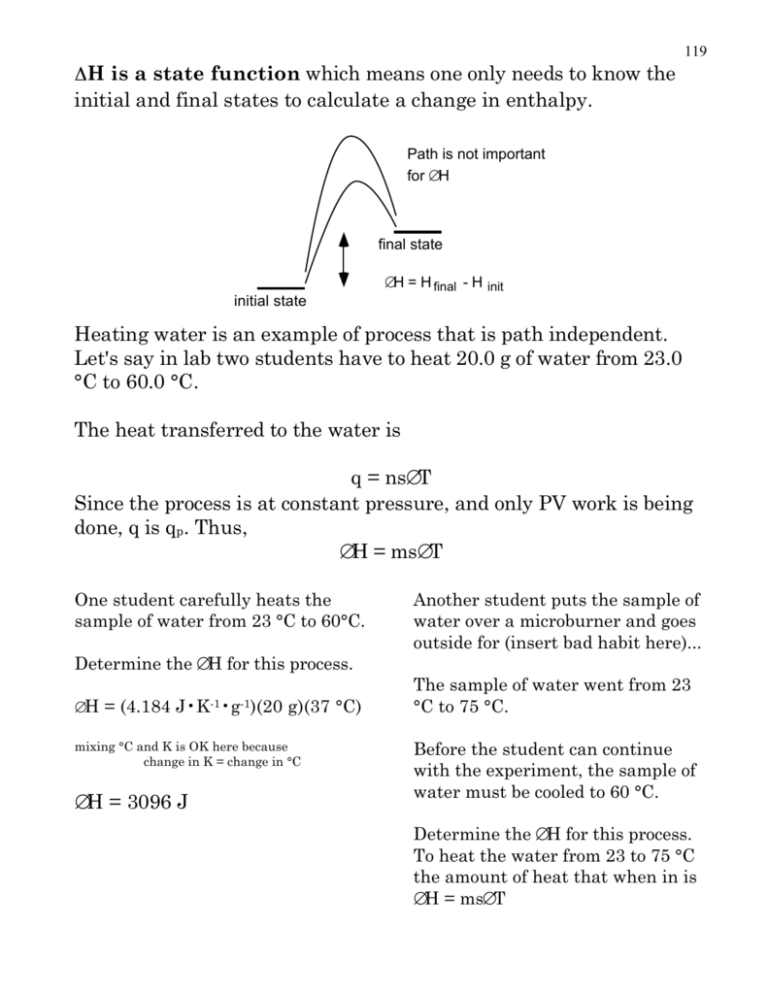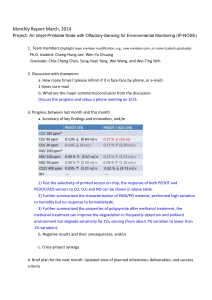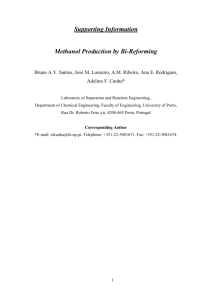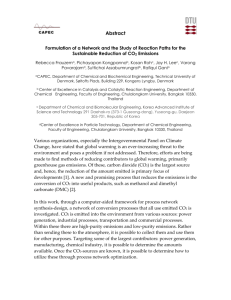p119-126 DH state and Hess
advertisement

119 H is a state function which means one only needs to know the initial and final states to calculate a change in enthalpy. Path is not important for ∆H final state ∆H = H final - H init initial state Heating water is an example of process that is path independent. Let's say in lab two students have to heat 20.0 g of water from 23.0 °C to 60.0 °C. The heat transferred to the water is q = ns∆T Since the process is at constant pressure, and only PV work is being done, q is qp. Thus, ∆H = ms∆T One student carefully heats the sample of water from 23 °C to 60°C. Determine the ∆H for this process. ∆ H = (4.184 J•K-1•g-1)(20 g)(37 °C) mixing °C and K is OK here because change in K = change in °C ∆H = 3096 J Another student puts the sample of water over a microburner and goes outside for (insert bad habit here)... The sample of water went from 23 °C to 75 °C. Before the student can continue with the experiment, the sample of water must be cooled to 60 °C. Determine the ∆H for this process. To heat the water from 23 to 75 °C the amount of heat that when in is ∆H = ms∆T 120 ∆H = (20g)(4.184 J g-1K-1)(75 - 23)K ∆H = (20g)(4.184 J g-1K-1)(60 - 75)K ∆H = 4351 J But the water had to cool back to 60 °C, and while the water was cooling heat was released. ∆H = -1255 J So, ∆H was 4351 J to get to 75 °C but on the way back to 60 °C 1255 J were released. ∆H = ms∆T ∆H = 4351 + -1255 = 3096 J student 2 final ∆H = H final - H init initial student 1 The energy that was actually transferred to the water is determined by comparing the initial and final states. Student 2 transferred extra energy into the water, but it was released by the water to the surroundings; so, in the end, students 1 and 2 transferred the same amount of energy to the water. What we have just demonstrated by example is Hess's Law. Hess's Law holds for ∆H of any process. Typically, chemists use Hess's Law to determine ∆H for reaction for a variety of reasons; we just may be to lazy to do the experiment, the experiment may be difficult or dangerous, or we may be making a survey to determine what reactions release the amount of heat we want. Let’s use Hess’s Law to determine the ∆H for the conversion of graphite to diamond. We can burn diamond and measure the amount of heat released. We can also measure the heat released when graphite is burned. Cgraphite(s) + O2(g) ——> CO2(g) ∆H= -394 kJ•mol-1 121 ∆H= -396 kJ•mol-1 Cdiamond(s) + O2(g) ——> CO2(g) We can add the reactions together to get the reaction we want Cgraphite(s) + O2(g) ——> CO2(g) ∆H= -394 kJ•mol-1 CO2(g) ——> Cdiamond(s) + O2(g) ————————————————— ∆H= 396 kJ•mol-1 —— ∆H= 2 kJ•mol-1 Cgraphite(s) ——> Cdiamond(s) Notice that since the second reaction is written “backwards” the reaction no longer releases 396 kJ; instead 396 kJ would have to be absorbed for the reaction to proceed. Cdiamond + O2 ∆H = ? kJ/mol Cgraphite + O2 H kJ ∆H = 2 kJ/mol ∆H = -394 kJ/mol ∆H = 396 kJ/mol CO2 The addition of the two reactions represented graphically CO2 122 Many alternative automobile fuels have been suggested. Methanol is one of them. There is an interesting way to boost the amount of energy that can be extracted from a methanol-powered engine. A catalyst can convert methanol to formaldehyde and hydrogen. The catalyst hastens the reaction, but the energy for the reaction comes from the hot exhaust. Experiments were performed to determine the heats of combustion of methanol, formaldehyde, and hydrogen. 2 CH3 OH(g) + 3 O2 (g) 2 H2 (g) + O2 (g) H2 CO(g) + O2 (g) 2 CO2 (g) + 4 H2 O(g) 2 H2 O(g) H2 O(g) + CO2 (g) ∆H = -1353 kJ ∆H = -484 kJ ∆H = -520 kJ Using this data determine the ∆Hrxn for the conversion of methanol to formaldehyde and hydrogen. 123 Rearrange the equations so that they add up to the reaction of interest. Methanol is a reactant so write the reaction down that involves methanol. 2 CH3 OH(g) + 3 O2 (g) 2 CO2 (g) + 4 H2 O(g) ∆H = -1353 kJ But we only need 1 methanol molecule, so cut the reaction in half... 1 2 2 CH3 OH(g) + 3 O2 (g) 2 CO2 (g) + 4 H2 O(g) ∆H = -1353 kJ We have to divide EVERYTHING including the ∆H. Since we are only doing half the reaction we only get half the energy. We need H2 as a product so the reaction must be turned around. 2 H2 O(g) 2 H2 (g) + O2 (g) If the reaction is turned around then the energy must be turned around too. The forward reaction released energy; to get the reaction to go backwards energy must be absorbed by the reaction. 2 H2 O(g) 2 H2 (g) + O2 (g) ∆H = + 484 kJ Once again we only need one H2, so divide by 2. 1 2 2 H2 O(g) 2 H2 (g) + O2 (g) ∆H = + 484 kJ Formaldehyde is also a product; so, its combustion reaction must be turned around. Since the reaction is being turned around, the sign of ∆H must be changed. H2 O(g) + CO2 (g) H2 CO(g) + O2 (g) ∆H = + 520 kJ Let’s add up all the reactions to see if we get the reaction we want. 124 1 CH3 OH(g) + 3 /2 O2 (g) 1 CO2 (g) + 2 H2 O(g) 1 H2 (g) + 1 /2 O2 (g) 1 H2 O(g) ∆H = -676.5 kJ ∆H = + 242 kJ H2 O(g) + CO2 (g) H2 CO(g) + O2 (g) ∆H = + 520 kJ CH3 OH(g) H2 CO(g) + H2 (g) ∆H = 86 kJ Warning: The ∆H’s here are given as heats of reaction. However, if someone were to announce that the heat of combustion of methanol is –677 kJ the ∆H is per mole. For example the statement: ∆Hcombustion = –677 kJ for methanol means that for each mole of methanol burned 677 kJ heat are released. Standard enthalpies of formation. ∆Hf° is the change in enthalpy associated with the formation of a compound from the elements. All reactants are in their standard states as defined on p 258. 1 / 2 N2 (s) + O2 (g) NO2 (g) ∆Hf° = 34 kJ From a table of ∆Hf° values reactions can be put together using Hess’s Law. Determine the ∆H for the following reaction MgO(s) + H2 O(l) Mg(OH)2 (s) Construct each compound from its elements and the sum the ∆Hf °. 125 The reactions are... Mg(s) + 1 /2 O2 (g) H2 (g) + 1 /2 O2 (g) MgO(s) H2 O(l) Mg(s) + O2 (g) + H2 (g) ∆Hf° = -602 kJ ∆Hf° = -286 kJ Mg(OH)2 (s) ∆Hf° = -925 kJ Use the ∆Hf° reactions to make the reaction of interest. Since MgO is a reactant, the MgO formation reaction must be turned around. Since the reaction is reversed, the ∆H must also be reversed; i.e., the additive inverse is used. MgO(s) H2 O(l) −∆Hf° = -( -602 kJ) Mg(s) + 1 /2 O2 (g) −∆Hf° = -( -286 kJ) H2 (g) + 1 /2 O2 (g) Mg(s) + O2 (g) + H2 (g) Mg(OH)2 (s) Mg(s) + O2 (g) + H 2 (g) + MgO(s) + H 2 O(l) MgO(s) + H2 O(l) ∆Hf° = -925 kJ Mg(OH) 2 (s) + Mg(s) + 1/ 2 O2(g) + H 2 (g) + 1 / 2 O2 (g) Mg(OH)2 (s) ∆Hf° = - 37 kJ You may have noticed that we do not have to write all this down. You may have noticed ∆H = ∆Hf°prod – ∆Hf°reactants Calculate ∆H for the following reaction using ∆Hf° values. 2 NH3 (g) + 3 O2 (g) + 2 CH 4 (g) 2 HCN(g) + 6 H2 O(g) construct each compound from its elements and the sum the ∆Hf °’s 126 3 /2 H2 (g) + 1 /2 N2 (g) 3 O 2 (g) ∆Hf° = 0 kJ 3 O 2 (g) C(s) + 2 H 2 (g) 1 ∆Hf° = - 46 kJ NH3 (g) /2 N2 (g) + C(s) + 1 /2 H2 (g) H2 (g) + 1 /2 O2 (g) ∆Hf° = -75 kJ CH4 (g) HCN(g) H2 O(g) ∆Hf° = 135.1 kJ ∆Hf° = - 242 kJ ∆H = ∆Hf°prod – ∆Hf°reactants ∆H = 6(-242 kJ) + 2(135.2 kJ) – 2(-75 kJ) – 3(0 kJ) – 2(-46 kJ) = -940 kJ






